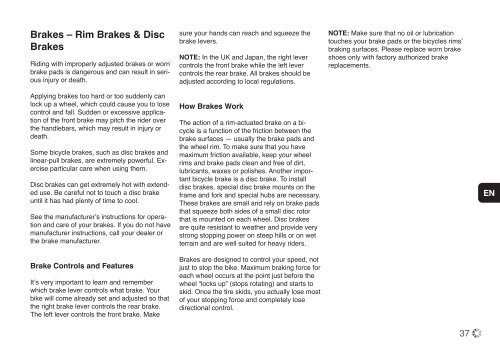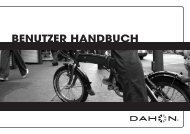BRUKERVEILEDNING - Dahon
BRUKERVEILEDNING - Dahon
BRUKERVEILEDNING - Dahon
You also want an ePaper? Increase the reach of your titles
YUMPU automatically turns print PDFs into web optimized ePapers that Google loves.
Brakes – Rim Brakes & Disc<br />
Brakes<br />
Riding with improperly adjusted brakes or worn<br />
brake pads is dangerous and can result in serious<br />
injury or death.<br />
Applying brakes too hard or too suddenly can<br />
lock up a wheel, which could cause you to lose<br />
control and fall. Sudden or excessive application<br />
of the front brake may pitch the rider over<br />
the handlebars, which may result in injury or<br />
death.<br />
Some bicycle brakes, such as disc brakes and<br />
linear-pull brakes, are extremely powerful. Exercise<br />
particular care when using them.<br />
Disc brakes can get extremely hot with extended<br />
use. Be careful not to touch a disc brake<br />
until it has had plenty of time to cool.<br />
See the manufacturer’s instructions for operation<br />
and care of your brakes. If you do not have<br />
manufacturer instructions, call your dealer or<br />
the brake manufacturer.<br />
Brake Controls and Features<br />
It’s very important to learn and remember<br />
which brake lever controls what brake. Your<br />
bike will come already set and adjusted so that<br />
the right brake lever controls the rear brake.<br />
The left lever controls the front brake. Make<br />
sure your hands can reach and squeeze the<br />
brake levers.<br />
NOTE: In the UK and Japan, the right lever<br />
controls the front brake while the left lever<br />
controls the rear brake. All brakes should be<br />
adjusted according to local regulations.<br />
How Brakes Work<br />
The action of a rim-actuated brake on a bicycle<br />
is a function of the friction between the<br />
brake surfaces — usually the brake pads and<br />
the wheel rim. To make sure that you have<br />
maximum friction available, keep your wheel<br />
rims and brake pads clean and free of dirt,<br />
lubricants, waxes or polishes. Another important<br />
bicycle brake is a disc brake. To install<br />
disc brakes, special disc brake mounts on the<br />
frame and fork and special hubs are necessary.<br />
These brakes are small and rely on brake pads<br />
that squeeze both sides of a small disc rotor<br />
that is mounted on each wheel. Disc brakes<br />
are quite resistant to weather and provide very<br />
strong stopping power on steep hills or on wet<br />
terrain and are well suited for heavy riders.<br />
Brakes are designed to control your speed, not<br />
just to stop the bike. Maximum braking force for<br />
each wheel occurs at the point just before the<br />
wheel “locks up” (stops rotating) and starts to<br />
skid. Once the tire skids, you actually lose most<br />
of your stopping force and completely lose<br />
directional control.<br />
NOTE: Make sure that no oil or lubrication<br />
touches your brake pads or the bicycles rims’<br />
braking surfaces. Please replace worn brake<br />
shoes only with factory authorized brake<br />
replacements.<br />
37<br />
EN





